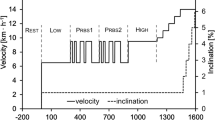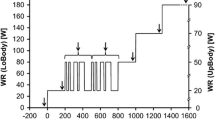Abstract
This project investigated the sensitivity of oxygen uptake (V˙O2) dynamics to training-induced physiological changes, across a broad spectrum of endurance-training histories. Forty subjects participated: sedentary (n = 10), active healthy (n = 10), regular runners (n = 10), and competitive distance runners (n = 10). Subjects completed a cycle step-function protocol, to elicit a steady state at 60% maximal work rate. Breath-by-breath data were collected for V˙O2 and cardiac frequency (ƒc), and modelled mathematically, and used to determine the average response times to attain 20%, 40%, 60%, 80% and 100% of the respective steady states. The between-group comparisons for both V˙O2 and ƒc revealed significantly faster response times to 40%, 60%, 80% and 100% of the induced response, for the better trained subjects (P < 0.05). In general, this technique permitted differentiation between the V˙O2 and ƒc response dynamics of non-elite subjects from a broad range of endurance-training histories, with differences becoming more pronounced as subjects approached the steady state.
Similar content being viewed by others
Author information
Authors and Affiliations
Additional information
Accepted: 22 May 1999
Rights and permissions
About this article
Cite this article
Taylor, N., Osborne, M., Bube, T. et al. Cardiorespiratory dynamics: sensitivity of the on-transition to endurance-training status. Eur J Appl Physiol 80, 505–507 (1999). https://doi.org/10.1007/s004210050625
Issue Date:
DOI: https://doi.org/10.1007/s004210050625




